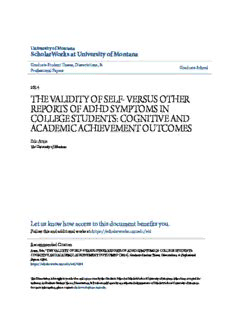
the validity of self- versus other reports of adhd symptoms in college students PDF
Preview the validity of self- versus other reports of adhd symptoms in college students
UUnniivveerrssiittyy ooff MMoonnttaannaa SScchhoollaarrWWoorrkkss aatt UUnniivveerrssiittyy ooff MMoonnttaannaa Graduate Student Theses, Dissertations, & Graduate School Professional Papers 2014 TTHHEE VVAALLIIDDIITTYY OOFF SSEELLFF-- VVEERRSSUUSS OOTTHHEERR RREEPPOORRTTSS OOFF AADDHHDD SSYYMMPPTTOOMMSS IINN CCOOLLLLEEGGEE SSTTUUDDEENNTTSS:: CCOOGGNNIITTIIVVEE AANNDD AACCAADDEEMMIICC AACCHHIIEEVVEEMMEENNTT OOUUTTCCOOMMEESS Eric Aune The University of Montana Follow this and additional works at: https://scholarworks.umt.edu/etd Let us know how access to this document benefits you. RReeccoommmmeennddeedd CCiittaattiioonn Aune, Eric, "THE VALIDITY OF SELF- VERSUS OTHER REPORTS OF ADHD SYMPTOMS IN COLLEGE STUDENTS: COGNITIVE AND ACADEMIC ACHIEVEMENT OUTCOMES" (2014). Graduate Student Theses, Dissertations, & Professional Papers. 4396. https://scholarworks.umt.edu/etd/4396 This Dissertation is brought to you for free and open access by the Graduate School at ScholarWorks at University of Montana. It has been accepted for inclusion in Graduate Student Theses, Dissertations, & Professional Papers by an authorized administrator of ScholarWorks at University of Montana. For more information, please contact [email protected]. Running Head: SELF AND OTHER REPORTS OF ADHD SYMPTOMS THE VALIDITY OF SELF- VERSUS OTHER REPORTS OF ADHD SYMPTOMS IN COLLEGE STUDENTS: COGNITIVE AND ACADEMIC ACHIEVEMENT OUTCOMES Education Specialist, University of Montana, Missoula, MT, 2009 Master of Arts, The University of Montana, Missoula, MT, 2008 Bachelor of Arts, University of Montana, Missoula, MT 2005 Dissertation presented in partial fulfillment of the requirements for the degree of Doctor of Philosophy In School Psychology The University of Montana Missoula, MT Official Graduation Date December 2014 Approved by: Sandy Ross, Associate Dean of The Graduate School Graduate School Margaret Beebe-Frankenberger, PhD, Chair Department of Psychology Stuart Hall, PhD Department of Psychology Daniel Denis, PhD Department of Psychology Cameo Stanick, PhD Department of Psychology Kari Harris, PhD School of Public and Community Health Sciences THE UNIVERSITY OF MONTANA Copyright © 2014 by Eric Aune Abstract Despite the abundance of studies investigating Attention-Deficit Hyperactivity Disorder in children and adults, little research has focused on ADHD and comorbid learning disabilities (LD) in college students. The dearth of research in this population is becoming increasingly important given that ADHD and LD are the two most commonly reported and diagnosed disabilities in higher academic institutions (National Center for Education Statistics, 2011). As a result, clinicians’ are continually faced with the difficult task of determining sensitive and valid assessment measures to use with this population. While some overlap exists between college students and younger and older counterparts, research has shown that this subpopulation represents a distinct subgroup of young adults further complicating diagnostic decisions and, ultimately, subsequent accommodation and intervention recommendations based on assessment results (Frazier, Youngstrom, Glutting, & Watkins, 2007). Little is known about the degree of concordance between self- and other reports of ADHD symptoms, both of which are commonly used in diagnostic decisions. This study was designed to investigate the relationship between self- and other reports of childhood/current ADHD symptoms and neurocognitive and academic achievement performance. Data for this study is based on students at-risk for learning and/or attention disorders that sought a comprehensive psychological evaluation at the University of Georgia Regents’ Center for Learning Disorders. The sample (N = 347) was comprised of three groups: (1) ADHD; (2) LD; and, (3) ADHD+LD. Participants were classified into three groups based on the results of the evaluation process and clinical diagnoses. Assessments utilized in this study included criterion- and norm-referenced ADHD measures, academic achievement, IQ, verbal memory, working iii memory, and processing speed tests. Results suggest that the relationship between self- and other ratings is strongest within scales regardless of time (childhood, current) or type of informant (self, parent). ADHD behaviors, as rated by self- and other report, were weakly correlated with neurocognitive measures and moderately associated with academic achievement test. Measures most sensitive to group differences were academic achievement tests; by in large, neurocognitive tests did not differentiate groups. Implications for future research are discussed. Keywords: ADHD, LD, college students, comorbid disorders, neuropsychological assessment, academic achievement, measures of ADHD, measures of LD, inter-rater reliability, behavior rating scale, neurodevelopmental disorders. iv TABLE OF CONTENTS List of Tables ................................................................................................................... vii List of Figures ................................................................................................................. viii CHAPTER 1. Introduction to the Study ............................................................................1 CHAPTER 2. Literature Review .......................................................................................5 A. History of ADHD ............................................................................................... 6 B. Genetic and Environmental Basis of ADHD .....................................................8 C. Neurobiology of ADHD .....................................................................................9 1. Theoretical Model of ADHD .................................................................9 2. Structural Imagining Studies ................................................................10 3. Functional Imagining Studies ..............................................................12 4. Neurocognitive and Academic Functioning in ADHD ........................15 D. Background of ADHD in Higher Academic Institutions .................................20 1. College Students with ADHD ...............................................................22 2. Self- and Other Report of ADHD Symptoms .......................................25 3. Evaluation of College Students with ADHD Symptoms ......................27 E. Rationale for the Present Study ........................................................................31 CHAPTER 3. Research Methodology .............................................................................33 A. Research Questions and Hypotheses ...............................................................33 1. Research Question 1 .............................................................................33 a. Hypothesis 1 .............................................................................33 2. Research Question 2 .............................................................................35 a. Hypothesis 2 .............................................................................35 3. Research Question 3 .............................................................................36 a. Hypothesis 3 .............................................................................36 4. Research Question 4 .............................................................................37 a. Hypothesis 4 .............................................................................37 B. Significance of Study ......................................................................................38 C. Methods ...........................................................................................................39 v 1. Participants ............................................................................................39 2. Procedure ..............................................................................................41 3. Grouping Criteria ..................................................................................42 a. ADHD ......................................................................................42 b. LD ............................................................................................43 c. ADHD+LD ..............................................................................43 4. Instruments .............................................................................................43 CHAPTER 4. Statistical Analyses and Results ...............................................................50 A. Design & Analyses ...........................................................................................50 B. Correlation Results ..........................................................................................55 C. Multivariate Results ........................................................................................62 CHAPTER 5. Discussion ..................................................................................................67 A. Limitations ......................................................................................................80 B. Summary and Future Directions .....................................................................82 REFERENCES .................................................................................................................85 APPENDICES .................................................................................................................101 vi LIST OF TABLES Table 1 Participants by Year in School......................................................41 Table 2 ADHD Descriptive Statistics by Groups.......................................51 Table 3 Neurocognitive and Academic Descriptive Statistics...................53 Table 4 ADHD Within Scale Correlations ................................................57 Table 5 ADHD Between Scale, Rater, and Time Correlations..................58 Table 6 ADHD Cluster Correlations..........................................................60 Table 7 ADHD, Neurocognitive, and Academic Correlations...................61 Table 8 Neurocognitive and Academic Correlations.................................63 Table 9 MANOVA and ANOVA Results..................................................64 vii LIST OF FIGURES Figure 1 Neurocognitive and Academic Profiles......................................................66 viii
Description: